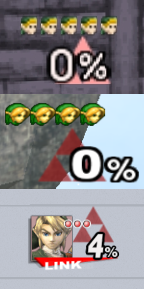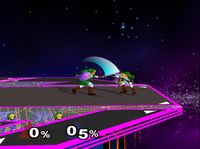Damage meter
The damage meter (also called the damage gauge, stamina meter, HP meter, HUD, player display, health meter, or hand among other names) is a UI element displayed during gameplay that presents basic information and status for each player at a glance. True to its name, the meter most prominently keeps track of a player's damage, though other statistics are generally shown here as well. In Super Smash Bros. Brawl and Super Smash Bros. 4, the damage display can be disabled in More Rules, although character portraits and other information will still be displayed. Super Smash Bros. for Nintendo 3DS also allows players to choose whether damage is displayed at the top or bottom of a character's portrait.
Layout
The damage meter displays the damage percentage a player has accumulated, as well as their score or number of stock remaining where appropriate. These are superimposed over a background featuring their series symbol and, starting with Brawl, their character's name and portrait (the symbol also gains an animated "smoky" texture.) The number of stock remaining is represented by the number of icons (nondescript circles in Brawl, the character's mugshot in other games), while score is displayed with a simple integer value. A stock higher than five (six in the original game) is represented by one icon with a multiplier value next to it; having fifteen stock, for instance, would show "× 15".
Damage meters are displayed at the bottom of the screen during gameplay on console installments and on the touchscreen in the 3DS version of Smash 4 (the Wii U version can also show a similar display on the GamePad.) While normally opaque, damage meters from Brawl onward become translucent if a character goes behind them. The damage percentage itself changes color when more damage is accumulated. At low percentages, the value is white, but gradually turns maroon as it increases; starting with Brawl, the value will also shift through red first, and Smash 4 further adds a yellow hue before that. In Smash 4, the damage percentage will stop turning darker at 200%, earlier than other games in the series. In addition, the Wii U version of Smash 4 displays the value with a metallic gradient. Starting in Brawl, the damage meter of a character who is KO'd appears to more or less "explode". In Smash Wii U, whenever someone is KO'd, the damage meter of whomever made the KO is briefly engulfed in flames.
Additionally, in all games, the background of a player's damage meter is colored depending on their controller port: for human players, Player 1 is red, Player 2 is blue, Player 3 is yellow, and Player 4 is green, while CPUs are generally a gray color. As of Smash 4, more colors have been added for Amiibo support and the Wii U version's eight-player capability: Player 5 is orange, Player 6 is cyan, Player 7 is purple, Player 8 is slate, and Amiibo FPs are rainbow-colored. Certain bosses in Smash 4 also have unique meter colors.
Additional info
The meter will sometimes show additional information during certain situations. This can be in the form of additional gauges and icons, or through alteration of existing elements. These include:
- Opponents with certain status effects in single-player modes will have cosmetic effects applied to their damage meters in some way. Most prominently are metal characters: in Melee, this was denoted by darkened stock icons, and similarly in Brawl with a darkened character portrait. In SSB4, the portrait is shown in grayscale. The original game gave Metal Mario a series symbol unique in that it is shaded in order to convey a metallic look, though it is arguable if this could technically be considered an alteration, as Metal Mario in that game is treated as completely separate character complete with his own series symbol, rather than simply Mario with a Metal Box effect.
- Alongside this, invisible and "dark" opponents in Melee have completely black stock icons, while false characters in Brawl's Subspace Emissary have a purple tint on their portraits.
- In Brawl and SSB4, icons for any Dragoon or Daybreak parts a fighter has collected will appear next to their portrait.
- In SSB4, Little Mac has a gauge above his damage meter that displays the charge for his KO Uppercut.
- In the Wii U version, if Shulk currently has a Monado Art active, its symbol is displayed above his portrait. This also happens for Kirby should he copy Shulk.
- Certain instances in SSB4 will cause the portrait's eyes to flash. This happens when a character activates a Final Smash or fully charges certain special moves (such as Giant Punch or Charge Shot). If a character receives an upgrade in the Find Mii stage, the eyes will glow constantly for the duration of the boost.
Stamina
In certain scenarios such as Stamina Mode or fights with bosses, a character's health is measured in HP rather than damage. In this case, the meter remains largely the same, though the value is affixed with an "HP" symbol rather than a percentage sign, counts down upon taking damage rather than up, and, in the Wii U version, shift through other colors, such as starting silver then turning bronze. These can appear alongside normal damage meters, such as the Master Hand fight where the boss's health is an HP value while the player retains the usual damage mechanic.
A different type of HP meter is used in the Subspace Emissary for all non-Smasher enemies, as well as in Brawl's Boss Battles mode. These meters are displayed as a horizontal red bar similar to a more traditional health bar rather than an exact numerical value, and appear above their owners for minor enemies and at the top of the screen for bosses. They are generally more difficult to strategize around, as one does not know exactly how much health an enemy has.
Unique among all enemies is Master Core in Super Smash Bros. 4 - its meter at the bottom of the screen is obscured in the 3DS version and disappears entirely in the Wii U version, intentionally making it impossible to know its maximum and current HP. In the 3DS version, once Master Core is defeated and reaches its final, vulnerable form, the swarm obscuring the meter clears to reveal the boss's identity and a standard damage percentage starting at 0%, as it must be KO'd normally to finally end the match. The meter does not reappear in the Wii U version, but the final goal remains the same.
Gallery
Damage meters for Mario and Bowser in Super Smash Bros. for Wii U.
Damage meters in Super Smash Bros. for Wii U, with eight human players.
Damage meters in Super Smash Bros. for Nintendo 3DS, displayed on the touch screen.
A damage meter glitch in Super Smash Bros. for Wii U. Note how no one has been attacked.
Trivia
- In Melee, when a character reaches a higher-digit damage value, their damage meter displays a leading zero on the frame they get hit. For example, raising one's damage from 7% to 12% will have the meter display 07% for one frame before it changes to 12%.
- In Melee, if a player is KO'd by a teammate, their damage meter returns to 0% using the "healing" animation instead of the "falling off" animation, before rising up from below the screen as usual.
- In Brawl, the black outline around the damage text is not part of the number textures like in the previous two games; it is instead drawn in real-time.
- Early footage of the Wii U version of SSB4 arguably seemed to show the damage value also shifting through a greenish hue before turning yellow; if this was actually the case, it is no longer so in the final release.
- When a character gets Screen KO'd in Brawl and SSB4, they will respawn before the "number breaking into pieces" animation even completes.
- In SSB4, Mr. Game & Watch's down tilt's windbox will cause the damage meter to flash despite the attack's windbox not dealing damage.








